Aiguamolls of L’Empordà
What are the Aiguamolls of L’Empordà?
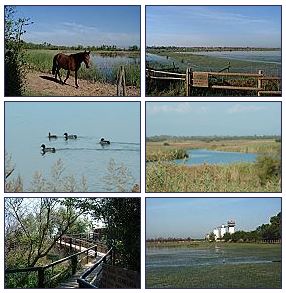 The Aiguamolls are nature reserves that protect areas of important coastal marshland in the Empordà. The one in the Alt Empordà is based on the rivers Muga and Fluvià and lies between Roses and Sant Pere Pescador, while the smaller one in the Baix Empordà includes the mouths of the river Ter just south of l’Estartit and the Basses d’en Coll on the Platja de Pals. These days, the name “Aiguamolls” is most commonly used to refer to the reserve in the Alt Empordà.
The Aiguamolls are nature reserves that protect areas of important coastal marshland in the Empordà. The one in the Alt Empordà is based on the rivers Muga and Fluvià and lies between Roses and Sant Pere Pescador, while the smaller one in the Baix Empordà includes the mouths of the river Ter just south of l’Estartit and the Basses d’en Coll on the Platja de Pals. These days, the name “Aiguamolls” is most commonly used to refer to the reserve in the Alt Empordà.
More than two millennia ago the swamp and dunes extended inland from the the Gulf of Roses and the Platja de Pals to completely surround the Montgrí massif, the lonely mountains that stand beside Torroella de Montgrí. The waters of the Ter, Fluvià and Muga were fused in a complex mosaic of lagoons, meanders and ponds that were flanked by dunes, mudflats, reedbeds and woodland. Together they formed a heterogeneous environment that was home to a multitude of birds, fish, mammals, reptiles and amphibians, as well as invertebrates in great numbers, to say nothing of the botany. The quantity and diversity would have dwarfed anything seen in any of today’s great protected parks of Europe. In more recent centuries, much of the area was given over to rice growing, but that has now largely ceased.
Nowadays, because of land drainage for cereal and livestock farming, the marsh area is considerably smaller and is divided into several parts, most of which are in the Alt Empordà. Nevertheless, the whole region is still one of the most important staging points in Europe for the spring and autumn migration by millions of birds crossing the Mediterranean to and from Africa.
In the mid-20th century, the tourist boom put additional pressure on the area, especially with the building of Empuriabrava right in the middle. Without a well-orchestrated popular campaign that began in 1976 to save and protect the Aiguamolls, everything would have been lost, and the entire coastline is likely to have disappeared under concrete. The goal of the campaign was attained in 1986, when the Generalitat de Catalunya (the Catalan Parliament) approved the creation of the Parc Natural del Aiguamolls de l’Empordà. Today, not only has the expansion of Empuriabrava been stemmed, but the protected area has been extended to cover a large tract of inland farmland surrounding the marshes. If one takes into account the Cap Creus nature reserve as well, a significant percentage of L’Empordà is now protected, which adds to the attraction for tourists while preserving the area and its wildlife for future generations.
What can be seen in the Aiguamolls?
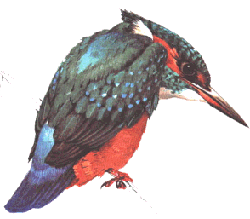 The first thing that a visitor notices is the environment, the space where the wild botany covers in all its variety the different areas from mudflats to flooded fields, beach dunes, banked dykes, dry stony heathland and grass pasturage. Each of these habitats has its own particular flora and fauna that change from season to season.The bird life is particularly impressive, and it is claimed that over 300 different species have been seen here. The best time to visit is in the spring and the autumn, to catch the passing migrants, but there is much to see all the year round. On arrival at the main car park at El Cortalet, the summer visitor will be greeted by the noise of white storks clashing their bills together. Within a couple of minutes you are likely to hear the loud call of Cetti’s warbler and the song of the nightingale – which, in spite of its name and reputation, sings throughout the day, too. Every day is different, but there are many species of waders here, ranging from the tiny little stint through the black-winged stilt with its extraordinarily thin red legs to the enormous flamingo.
The first thing that a visitor notices is the environment, the space where the wild botany covers in all its variety the different areas from mudflats to flooded fields, beach dunes, banked dykes, dry stony heathland and grass pasturage. Each of these habitats has its own particular flora and fauna that change from season to season.The bird life is particularly impressive, and it is claimed that over 300 different species have been seen here. The best time to visit is in the spring and the autumn, to catch the passing migrants, but there is much to see all the year round. On arrival at the main car park at El Cortalet, the summer visitor will be greeted by the noise of white storks clashing their bills together. Within a couple of minutes you are likely to hear the loud call of Cetti’s warbler and the song of the nightingale – which, in spite of its name and reputation, sings throughout the day, too. Every day is different, but there are many species of waders here, ranging from the tiny little stint through the black-winged stilt with its extraordinarily thin red legs to the enormous flamingo.
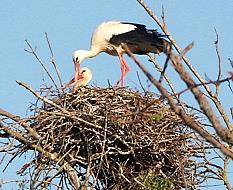 All of Europe’s most colourful birds can be found here: the kingfisher, the hoopoe and – in season – the bee-eater and the roller. It is not difficult to see the unmistakable silhouette of the cormorant adoring the sun with its open wings, while in the background you will hear the strange cry of the water rail skulking in the reeds and sounding like a squealing pig. Marsh harriers patrol the reedbeds, gliding slowly in low arcs seeking among the rushes something that is worth the dive for a quick meal and scattering the colourful ducks in a panic. Meanwhile, many kinds of herons and egrets stalk fish at the water´s edge. In winter, hundreds of goldfinches flock to search for seeds in the dry vegetation. This is the best time to see the smaller birds, such as the pretty penduline tit with its black mask, the black redstart that bobs up and down flicking its red tail and the snipe with its long beak digging in the mud. Serious birdwatchers can pass many happy hours searching for crakes, bitterns and stone curlews, amongst many other interesting species.
All of Europe’s most colourful birds can be found here: the kingfisher, the hoopoe and – in season – the bee-eater and the roller. It is not difficult to see the unmistakable silhouette of the cormorant adoring the sun with its open wings, while in the background you will hear the strange cry of the water rail skulking in the reeds and sounding like a squealing pig. Marsh harriers patrol the reedbeds, gliding slowly in low arcs seeking among the rushes something that is worth the dive for a quick meal and scattering the colourful ducks in a panic. Meanwhile, many kinds of herons and egrets stalk fish at the water´s edge. In winter, hundreds of goldfinches flock to search for seeds in the dry vegetation. This is the best time to see the smaller birds, such as the pretty penduline tit with its black mask, the black redstart that bobs up and down flicking its red tail and the snipe with its long beak digging in the mud. Serious birdwatchers can pass many happy hours searching for crakes, bitterns and stone curlews, amongst many other interesting species.
What are the specialities of the Aiguamolls?
For some years now there has been a managed breeding program here for white storks. Many special nesting platforms have been built for them, but clearly the birds have other ideas, because you will find storks nesting on top of electricity pylons too!
The mascot of the APNAE group (Friends of Aiguamolls) is another speciality of the reserve, the purple gallinule, a bird rarely seen elsewhere in Europe. It looks like a big blue moorhen with red legs and beak and makes an extraordinary noise.
The reserve has also been used for the breeding and successful reintroduction of the otter, and you will occasionally see its footprints. Perhaps you will be lucky enough to see the animal itself!
Birdwatching itineraries, and available materials
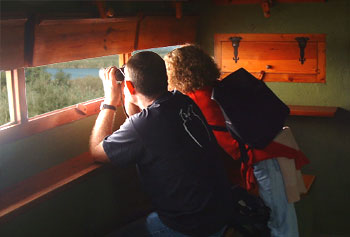 The reserve is well-equipped with paths for visitors to choose for their excursions. The itineraries are clearly marked, and there are numerous bird hides along the way which provide excellent vantage points to see the birds and animals without disturbing them. Please remember to shut the doors and windows quietly when you leave. We advise every new visitor to first go to the information centre at El Cortalet to get a map to plan your route. You can also buy guide books there in several languages, though the most useful one – the Guia d’itineraris – is in Catalan. Depending on whether you go north from El Cortalet or south, you will see different things. The north is drier, so there are more farmland birds and flowers of the open countryside. The south is mainly marshland, so here you will see most of the aquatic species.
The reserve is well-equipped with paths for visitors to choose for their excursions. The itineraries are clearly marked, and there are numerous bird hides along the way which provide excellent vantage points to see the birds and animals without disturbing them. Please remember to shut the doors and windows quietly when you leave. We advise every new visitor to first go to the information centre at El Cortalet to get a map to plan your route. You can also buy guide books there in several languages, though the most useful one – the Guia d’itineraris – is in Catalan. Depending on whether you go north from El Cortalet or south, you will see different things. The north is drier, so there are more farmland birds and flowers of the open countryside. The south is mainly marshland, so here you will see most of the aquatic species.
Throughout the park are viewpoints that give a panoramic view of lagoons and places worthy of special attention. It is from these viewpoints that we can appreciate the true wealth of the Aiguamolls of L’Empordà. For that reason the use of binoculars is strongly recommended to improve upon the visual opportunity that the park offers the naked eye. It is amazing to look through binoculars at what appears at first sight to be an empty meadow only to find it crawling with dozens of camouflaged birds. One of the best areas is the old rice fields to the south of El Cortalet. There are three old rice silos here at Sennilosa, one of which was converted in 1996 into an observation platform 22 metres high. The view it gives over the whole reserve is impressive, though binoculars are recommended, or even a telescope. For photographers a telephoto lens is essential, and yet never long enough.
The value of Els Aiguamolls de L’Empordà
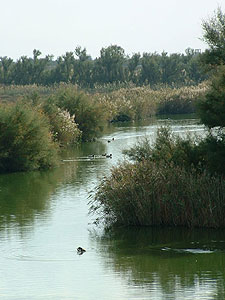 Much has been written of the need to preserve natural spaces like the Parc Natural dels Aiguamolls de L’Empordà. In our case, not only does it provide protection for endangered species and a safe haven for migrants, but it also has an educative value that can be seen from the many parties of schoolchildren that visit with their teachers to learn about their natural heritage
Much has been written of the need to preserve natural spaces like the Parc Natural dels Aiguamolls de L’Empordà. In our case, not only does it provide protection for endangered species and a safe haven for migrants, but it also has an educative value that can be seen from the many parties of schoolchildren that visit with their teachers to learn about their natural heritage
Biodiversity is passing through a critical period globally. Yet here we can enjoy at first hand a primitive sensation of encountering what lies deep in our soul, perhaps intensified by memories of our childhood, perhaps through consciousness of the inheritance of our past when human beings were still at one with their natural surroundings. We may contemplate, catch the scents on the breeze, listen to the voices of the fields and feel the heartbeat of the calm soul that is once more at home, and perhaps should never have left.
The information office El Cortalet (Tel. 972 454222) is easy to reach and is clearly signposted; take the road from Castelló d’Empúries towards Sant Pere Pescador, and about three kilometres south of the Figueres-Roses (C-260) road turn left by the riding stables and follow the lane until you reach a large shady car park. The information office is in the large building alongside.
The office is open from April to September daily from 9.30am to 2pm and again from 4.30pm to 7pm. From October to April the times are 9.30am to 2pm and 3.30pm to 6pm.
————————————————————————-
EL CORTALET: Cra. de Sant Pere Pescador km 13,6
17486 Castelló d’Empúries
Tel: 972 45 42 22
Fax: 972 45 44 74
————————————————————————-
Pictures from Aiguamolls of L’Empordà:
————————————————————————- [cetsEmbedGmap src=http://maps.google.es/maps?f=q&source=s_q&hl=es&geocode=&q=aiguamolls+de+l%27emporda&sll=39.96028,-3.713379&sspn=7.981087,14.128418&ie=UTF8&hq=&hnear=Parc+Natural+dels+Aiguamolls+de+l%27Empord%C3%A0&t=p&z=11 width=350 height=425 marginwidth=0 marginheight=0 frameborder=0 scrolling=no]————————————————————————-













